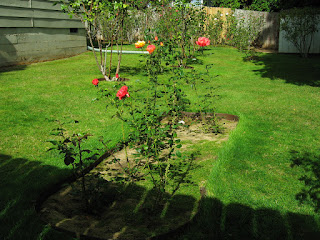If you keep growing roses long enough, and you try stimulating their growth in a variety of ways, something extraordinary might just happen. Such is the case with one of my rose seedlings, which has been receiving, along with around 20 of my other slower growing seedlings, a daily (for the last 30 days) foliar spraying of a solution of
SUPERthrive, which I have mixed at double the suggested strength
. On a newly developed cane, this particular rose bush has produced a mutant bloom having 12 petals (with a bloom diameter of 3 inches). The norm for this seedling has been, and still is, blooms of 5 to 6 petals (with bloom diameter of 2 inches).
Below are three photos that I took today. The first photo shows the entire seedling rose bush, with a normal bloom on a taller cane. The mutant bloom is on a newly formed separate cane, and is the lower bloom in the same photo. The second and third photos show close-ups of the individual blooms. There is also a fourth photo, one that I took exactly 2 years ago of the seedling when it was producing "normal" blooms exclusively. I did a post back then which featured this seedling -- look for the post titled
The "underdog" rose bush.
 |
An otherwise normal rose bush
Photo taken: September 10, 2018 |
 |
The mutant bloom
Photo taken: September 10, 2018 |
 |
A normal bloom
Photo taken: September 10, 2018 |
 |
Two years ago
Photo taken: September 10, 2016 |
Update of November 20, 2018: There was some doubt whether this small rose bush would produce more blooms before Winter set in. Fortunately, the "mutant cane" developed another flower, but I had to assist it by holding the bloom open for this photo shot, because the weather is too cold. As you can see, the "mutation" appears to be a "one off" event, as there's been a reversion back to five petals. I'll do another update next year if things change again. The bloom is shown in both photos below, and so are some CD's (??). I'll explain when I write another post next month (December 5th to be exact).
 |
| Photo taken: November 20, 2018 |
 |
| Photo taken: November 20, 2018 |


















































